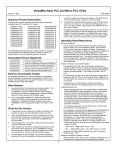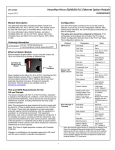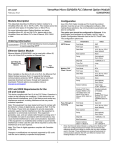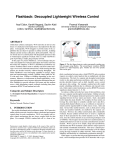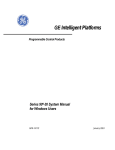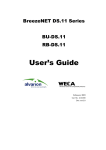Download VersaMax Nano/Micro PLC IPI, GFK
Transcript
VersaMax® Nano PLC and Micro PLC CPUs September 2009 GFK-2566A Important Product Information This document contains important information about the following VersaMax Nano PLC and Micro PLC models: IC200NAL110-CE IC200NAL211-CE IC200NDD010-DG IC200NDD101-DG IC200NDR001-DG IC200NDR010-DG IC200UAA003-CJ IC200UAA007-CH IC200UAL004-CH IC200UAL005-CH IC200UAL006-DJ IC200UAR014-CJ IC200UAR028-CH IC200UDD020-AB IC200UDD040-AB IC200UDD064-AF IC200UDD104-CJ IC200UDD110-CH IC200UDD112-CJ IC200UDD120-CH IC200UDD164-AF IC200UDD212-CH IC200UDD220-AB IC200UDD240-AB IC200UDR001-CJ IC200UDR002-CJ IC200UDR003-CJ IC200UDR005-CH IC200UDR006-CH IC200UDR010-CH IC200UDR020-AB IC200UDR040-AB IC200UDR064-AF IC200UDR120-AB IC200UDR140-AB IC200UDR164-AF IC200UDR228-BB IC200UDR440-AB IC200UMB001-A IC200USB001-A IC200USB002-A IC200UUB001-A ▪ Micro-40 CPU and Ethernet Option Module: Micro-40 CPUs are compatible with Ethernet Option Module IC200UEM001-AB and later revisions only. ▪ Release 3.55 for 23-point and 28-point CPUs requires Proficy Machine Edition 5.0 or later. ▪ VersaPro 2.04/PME 5.0 and later releases can be used with firmware release 3.57 (Micro 14, Nano and Analog Nano CPUs). ▪ Firmware version 3.57 is compatible with all previous hardware revisions of the Micro 14, Nano, and Analog Nano CPUs. ▪ Micro 14, Nano, Analog Nano, CPU Hardware Compatibility: The Micro 14, Nano, and Analog Nano CPU hardware versions listed below require version 3.56 firmware or later. They are not compatible with any prior firmware release. IC200NAL110-Cx IC200NAL211-Cx IC200NDD010-Dx The suffix letters following CPU part numbers indicate the hardware version followed by the firmware version. Expansion units do not have firmware, so only the hardware version is indicated. Suffix A or AA indicates a new module. IC200NDD101-Dx Functional Compatibility IC200UAR014-Cx ▪ Firmware version 3.83 is compatible with all previous versions of Micro-20, Micro-40, and Micro-64 CPUs. ▪ Proficy® Machine Edition 6.0 (PME) SIM1 and later versions are required for Ethernet Throughput Enhancement and Modbus Client support. ▪ Ethernet Option Module firmware version 2.0 or later is required to support CPU version 3.83 features. IC200NDR001-Dx IC200NDR010-Dx IC200UAA003-Cx IC200UDD104-Cx IC200UDD112-Cx IC200UDR001-Cx IC200UDR002-Cx IC200UDR003-Cx ▪ Note: The CPU catalog suffixes have not been changed for the 3.82 and 3.83 firmware versions. ▪ VersaMax Micro 64 requires Proficy Machine Edition 5.5 SP2 SIM5 or later. ▪ Support for Micro Motion Modules in the VersaMax PLC system requires Proficy Machine Edition 5.7 SIM 3 or later. ▪ The motion functionality available on VersaMax Micro CPUs is not guaranteed, as it is not tested, with the following VersaMotion servo amplifiers IC800VMA012, 022, 042, 072, 102, 202, or 302. ▪ ▪ Downloadable Firmware Upgrade Kits Downloadable firmware is available at http://www.gefanuc.com/ Performance: For details on features in release 3.83, refer to the addendum, Additional Important Product Information for Release 3.83, GFK-2568 or the VersaMax Nano and Micro PLCs User’s Manual, GFK-1645J or later. Review the VersaMax Nano/Micro PLC User’s Manual, GFK-1645G or later for updated performance information. Scan times are longer for Micro-64 CPUs due to the increased I/O counts. This can affect serial communications times at lower baud rates. The T2 SNP time may be longer in some setups using Micro-64 CPUs. Application timeouts may need to be increased at baud rates of 2400 baud or less for RTU and Serial I/O communications. Configuration equality with New PME (6.0 SIM1 and above) and Old Firmware (prior to release 3.83): After auto configuration, upon upload of configuration from PLC with older firmware revisions, the Status Bar in PME shows Config NE. This issue is applicable to all VersaMax Nano/Micro CPUs. All VersaMax Micro CPUs support 8- and 16-point expansion units even though older programming packages may not have them in the configuration. To configure these expansion units with VersaPro, allow the CPU to autoconfigure the expansion units, and upload the configuration into VersaPro. 44A753036-G09 R3.83 for Micro-64 CPUs 44A753291-G04 R3.83 for Micro-40 CPUs 44A753290-G04 R3.83 for Micro-20 CPUs 44A752236-G07 R3.57 for Micro-14 CPUs 44A752239-G04 R3.56 for all Nano CPUs except IC200NAL110/211 44A752240-G04 R3.56 for Analog Nano CPUs IC200NAL110/211 44A752237-G07 R3.55 for all Micro-23, and -28 CPUs except IC200UDD120 44A752238-G07 R3.55 for Micro-28 CPU with ESCP, IC200UDD120 Downloadable Protocol Upgrade Kits (Ethernet Drivers) Note that this issue is not present with the new (release 3.83 and above) firmware. 1 82A1587-MS10-000-B0 SRTP upgrade kit 82A1588-MS10-000-B0 Modbus TCP upgrade kit 82A1589-MS10-000-B0 Pass through upgrade kit VersaMax® Nano PLC and Micro PLC CPUs September 2009 GFK-2566A Electronic Documentation Available 3. When HSC was configured for Type-B (16/32) and count direction set All VersaMax Nano/Micro PLC user documentation, specifications and CAD drawings are available for download from Technical Support area of the GE Fanuc website, http://www.gefanuc.com Printed user manuals are available as part number GFK-1645. 4. In the HSC 32-bit counter when a count span (high limit – low limit) was as Down, the Preload value applied through the Load Preload COMMREQ was not updated properly in the accumulator. The Load Preload COMMREQ now supports Type-B configuration. given in (multiples of 65536), (multiples of 65536) + 1, or (multiples of 65536) + 2 at high input frequencies, such as100kHz, the counter counted beyond the limit. Problems Resolved in Release 3.83 Release 3.83 is for Micro-20/40/64 CPU models only. It does not affect any other Micro or Nano PLC models. Release 3.83 corrects the following issues: 1. 2. On Micro-20/40/64 CPUs with Ethernet option board connected on Port 2 acting as an RTU slave, when the master triggered a Preset Multiple Registers Command, a ““Response Timeout” error was received in the COMMREQ of the RTU MODBUS master. On Micro-20/40/64 CPUs with an Ethernet Option Module connected on Port 2, a Memory Pack Module stacked on top of it, and a programmer connected on Port 1, read and write operations to the flash device resulted in the error “Flash operation failed [PLC Error].” However, the CPU executed the read and write operations successfully. This problem was caused by the timeout value programmed in the Ethernet Option Module and has been resolved in release 3.83. 3. With an Ethernet Option Module connected to Port 2 of a Micro20/40/64 CPU, the Force Listen Mode command failed. The command generated an unexpected response, which was the same as the request. In release 3.83, no response is generated for this command, as expected. 4. If communication was lost between a Micro configured as Master and another Micro configured as Slave through radio modems using SNPX protocol, the Slave would not respond to subsequent commands from the Master even after communication was reestablished. A power cycle of the Slave Micro was required to restore the communication. The HSC 32-bit code design now supports higher input frequencies. This issue applies to both Type-A and Type-B configurations. Problems Resolved for Release 3.81 Not applicable. Problems Resolved for Release 3.57 When PWM frequency was changed, during frequency transition the PWM output could stay idle for some time. For release 3.57, the length of the pause caused by the frequency change has been shortened as described in the Operating Notes section. Problems Resolved for Release 3.56 Release 3.56 is for Micro-14, Nano, and Analog Nano CPU models only. It does not affect any other Micro or Nano PLC models. Release 3.56 corrects the following issues: 1. Serial communications at 38.4k baud are improved, and modules are now able to communicate with QuickPanel. 2. In the previous firmware versions, SVC_REQ 52 (Read from User Flash) used three words for its status data instead of two. For release 3.56, this data uses only two status words. 3. In previous firmware versions, when a watchdog timeout occurred, the hardware configuration, user program and reference tables were cleared. In version 3.56, the hardware configuration, user program and reference tables are retained. 4. In previous firmware versions, if the PLC was powered off during a Write to Flash (through online commands in PME) operation, the logic, hardware configuration and reference tables were cleared. In version 3.56, the user program, hardware configuration and reference tables are retained. In release 3.83, the power cycle is not required to restore the communication. 5. In the earlier firmware revisions the user was not able to write more than 4 words/64bits using the SRTP Write Multiple Bits/Bytes command. Multiple SRTP write commands were needed to write more than 4 words. In release 3.83, the SRTP Write Multiple Bits/Bytes command can be used to write a maximum of 2048 bytes into the server device in a single command. Problems Resolved for Release 3.55 1. Serial communications at 38.4k baud are improved, and modules are now able to communicate with QuickPanel. 2. In the previous firmware versions, SVC_REQ 52 (Read from User Flash) used three words for its status data instead of two. For release 3.55, this data uses only two status words. Problems Resolved in Release 3.82 Release 3.82 is for Micro-20, 40 and 64 CPU models only. It does not affect any other Micro or Nano PLC models. Release 3.82 corrects the following issues: 1. When PWM frequency was changed, during frequency New in Release 3.83 New Features for Micro 20/40/64 Point CPUs transition, the PWM output stayed idle for some time. Baud rate up to 175 Kbps supported on Port 2 for Ethernet Option Module. For release 3.82, this pause in PWM output has been eliminated. Modbus/TCP Client functionality. New function block to support the Modbus Client functionality. 2. When HSC was configured for Type-A (16/32) and count direction set as Down, the Preload value applied through the Load Preload COMMREQ was not updated properly in the accumulator. The Port 2 default baud rate setting, when auto configured with Ethernet Option Module connected, is changed from 19.2 Kbps to 175 Kbps. New Features for Ethernet Option Module The accumulator is now updated correctly with the Preload value. SRTP, Modbus TCP, and Pass-through protocols support 175 Kbps Modbus TCP Client functionality. Support for two security settings: Enhanced password support for Telnet configuration and SNMP configuration (for Enabling or Disabling). 2 VersaMax® Nano PLC and Micro PLC CPUs September 2009 GFK-2566A Uploading the logic with real data, results in losing the precision of the real constant values. When user logic containing the REAL data values is uploaded, its precision is lost in PME and hence Equality of the logic is lost. This is because PME represents the value of real number in scientific notation with precision of 6 digits after decimal point. Restrictions/Operating Notes ▪ ▪ Piggyback Status using SNP Master: An SNP Master Protocol Long Attach COMMREQ may return all zeros in the piggyback status word for the slave device when using a modem or when used at 38400 baud. (Micro 20/40/64) For example, if a value of 2147483648.0 is uploaded, it is represented in PME as 2.147484e+009 (i.e. only 6 digits after decimal), which is equivalent to 2147484000.0 (round off, which is an error). If this value is downloaded to the CPU, it is stored as 2147483904.0 (rounded off, which is expected as per the IEE-754 32 bit representation of the REAL type). Data transfer between PLCs using a SET (Serial Ethernet) module. CPU with a SET module connected on the Port 2, when configured for Serial IO with a baud rate of 38400, does not allow the slave PLC to read the data written by the master PLC, that is, the values returned are all zeros. The data is read correctly when an Ethernet option board is used instead of the SET module. (Micro 20/40/64) Under a few conditions, changing Ethernet Board configuration causes the CPU to go to Blink mode. This issue is present when Port 2 is configured for Ethernet with Modbus Client Enabled and under the following conditions: PME hardware configuration is downloaded to the Micro, with Ethernet Option Module configuration changed, particularly from 175K to 38.4K baud with also change in parity. Subsequently saving the Ethernet Module configuration causes the Stop Faulted mode of Micro, with its OK LED blinking. To recover from this faulted mode, cycle power to the Micro PLC. (Micro 20/40/64) CPU becomes non functional when HSC is configured for minimum count span and subjected to higher input frequency. When HSC (16-bit/32-bit) counter is configured for a minimum count span of 0, 1 or 2 at the maximum frequency, 100 kHz, the Watchdog timer expires, the OK LED is switched OFF, and only the Power LED glows. Under specific high and low limit ranges, the HSC one shot mode is not working as per the information provided in the user manual. For HSC one shot mode, the user manual states that for up counting the counter stops at N+1 and for down counting the counter stops at N-1. The expected behavior is observed when both high and low limits are configured with negative values, or high limit is configured with positive value and low limit is configured with negative value. But if both high and low limits are configured with positive values, when down counting, the counter stops at N instead of N-1. When up counting with this configuration, the counter stops at N+1 as expected. In PME, uploading a configuration and then changing the Port 2 Configuration in CPU Settings can result in non default values being displayed on the Port 2 settings tab. To work around this issue, change the Port Mode setting of Port 2 to a different protocol and then back again. (For example, change Port Mode from SNP to RTU and back to SNP again.) After this procedure, the Port 2 tab will show default settings. (Micro 20/40/64) ▪ Analog Expansion Module Failures. When an analog expansion module (IC200UEX616, IC200UEX626, IC200UEX636) fails, it drives a signal low, which in turn causes the loss of all other analog expansion units in the system. Discrete expansion units cabled after the first analog expansion unit will also be lost. This failure can also subsequently affect the operation of any discrete expansion units, should any of them later be powered down. Consult the user’s manual, GFK-1645, for detailed troubleshooting instructions to be used in isolating expansion unit failures. (Micro 20/40/64) ▪ DIP Switch Controls Analog Scaling Range. DIP Switch SW6 on an analog expansion unit controls the maximum value for the unit’s analog inputs and analog outputs as follows: Example: If the low limit is 10 and high limit is 100, for up counting it stops at 101 (i.e N+1) but for down count it stops at 10 (i.e. N) instead of 9 (i.e. N-1). ▪ At higher input frequencies, HSC Type-B 32-bit counter doesn’t count input pulses properly. At higher input frequencies, say 100kHz, the number of “A quad B” phase inputs given does not match the counts counted by the Type B 32-bit counter. Modbus/TCP Client feature stops working while the CPU is fully loaded, or Modbus/TCP Client (Rx3i) gives error 0x0B91 for one of seven TCP server channels opened in the VersaMax Nano/Micro PLC. Under full load conditions (Example: Port 1 and Port 2 engaged in Modbus RTU communication, PTO at 65KHz, 3 HSC channels configured as counters, and 4 expansion modules connected), sometimes the Micro does not respond to one of the Modbus commands. Under such full load conditions, Micro’s UART occasionally fails to process one-byte information, which is the cause of the problem. This issue is not observed with 175K baud rate. To correct this problem, have the Client PLC resend the command when the error 0x0B91 is received. SW6: OFF ⇒ 4096 (32767 counts = 10V) ON ⇒ 4000 (32000 counts = 10V, 32767 counts = 10.23V) By default, DIP Switch SW6 should be set in the OFF position (32726 counts = 10V). (Micro 14/23/28/28 ESCP/20/40/64) ▪ PWR LED Status on Analog Expansion Units. On the analog expansion units (IC200UEX616, IC200UEX626, IC200UEX636), the PWR LED will be on if any other expansion unit or the CPU to which it is connected is powered up. This is due to a “power bleed” issue in the cabling to the unit. (Micro 20/40/64) ▪ Input References Used by the High-speed Counter: For all Nano and Micro PLCs that support High-speed Counters, input references %I489 - %I493 are reserved for the embedded HSC function, and are not available to the application program. Watchdog times out when SNPX write command is triggered after Update real time datagram command. Whenever a SNPX write command is fired after update real time datagram command, the watchdog times out for the few combinations of SNP timer values Example: T1 = 100, T2 = 0 (Disabled), T3 = 0 (Disabled), T4 = 2000, T5 = 0 (Disabled). ▪ Winloader is able to update the firmware with OEM locked. When OEM key is enabled, updating the firmware should be possible only by entering the OEM key password. Currently, even when the OEM key is enabled, firmware update is possible without password prompt. Recommendation: Avoid using references %I489 - %I493 (which are located immediately before the rest of the HSC input references) in the application program. High-speed Counter COMMREQs: For all Nano and Micro PLC types that support High-speed Counters, when sending data commands to the High-speed Counter using the COMMREQ function, the CPU ignores the data type and start location parameters. These parameters specify where the command and data words are located in CPU memory. The CPU expects these three parameters to be located immediately after the command block. Recommendation: Be sure the command word and data words are located contiguously in memory, with the rest of the COMMREQ 3 VersaMax® Nano PLC and Micro PLC CPUs September 2009 GFK-2566A register does not provide consistent results when the HSC is used to measure signals of continuously varying frequency (the data values are not consistent). This does not happen while measuring a signal with constant frequency. command block. They should immediately follow the "Start Location of Command Word" in the COMMREQ command block. ▪ ▪ Hardware Flow Control: For all Nano and Micro PLC CPUs, hardware flow control should only be configured if the Micro PLC will be used with a modem or other device that requires that functionality. In a point-to-point setup, configuring the units for hardware flow control may cause the units to fail to respond. The default setting is no flow control. RTU Communications: Micro-23, -28, and -64 PLC CPUs, RTU communications on port 2 are not reliable with large programs when scan times are above 140 milliseconds. Using Constant Sweep mode may improve communications by allowing a larger communications window at the end of the sweep. ▪ When uploading a configuration from the CPU to the Programmer, 8 and 16 point expansion units may show up in the configuration as other expansion modules, but with similar I/O sizes. ▪ Serial Option Module Signal Pins: Option Modules IC200USB001 and USB002 for Micro-20/40/64 PLCs do not contain RTS/CTS signal lines. These ports cannot be used with modems and repeaters that require hardware flow control. ▪ ▪ ▪ Shorting Signals on Port 2 Causes Reset: On Micro-23, -28, and -64 PLC CPUs, a short on the 5V line on Port 2 causes the CPU to power off. Power returns when the short is removed. ▪ Ethernet Option Module on Micro-20/40/64 CPU: If four SRTP channels are active at the same time, communication does not take place on COM1, so the CPU cannot communicate with the Machine Edition programmer on COM1. Communications can take place on COM1 as long as not more than three SRTP channels are active. ▪ Positive or negative transition coils in a jump region or a subblock: If the application program includes any transition coils within a jump region, sub-block, or similar area, and the transition coils are not executed in the scans after the coils set their reference address, and the PLC is placed in Stop No I/O mode, the coils’ reference will not respond as expected after a Clear Initial Values command. In such a situation, use the Clear All command instead. ▪ Output Waveform During PWM Frequency Change: During PWM frequency change, a Long OFF or Long ON may occur at the first pulse of the new frequency. Examples are illustrated below. Long OFF: Memory Option Module Write-Protect Switch: The Memory Option module IC200UMB001 for Micro-20/40/64 CPUs has a Write-Protect switch. The default for this switch is to allow all write operations. If the switch is changed to prevent writing to the memory module, there is no feedback to the CPU that the write has not occurred. Use caution when changing this switch position. Frequency change initiated Communicating through USB: When using the USB Option module with a 20/40/64 Point CPU, the Machine Edition configuration parameters for Port 2 should be left at their defaults 19200, Odd parity, 1 stop bit, no flow control. These parameters match the FTDI USB driver configuration in Windows. Long OFF If the transition occurs while the pulse is OFF, the maximum time the output is OFF is equal to the old frequency OFF state duration plus the new frequency pulse duration. Do not unplug the USB cable while communicating with the unit. Windows requires that the device to be stopped through the USB driver before disconnecting the cable. ▪ Logic-Driven Write to Flash: Parameters stored to a Micro-14/23/28/20/40/64 CPU using the Logic Driven write to Flash feature are erased during a firmware upgrade. ▪ Counter Disabled Functionality for PTO: For all Nano and Micro PLC types that support High-speed Counters, when a channel is being configured for PTO or PTO w/Ramp, if the Counter Disabled parameter is visible in the programming software, it has no effect. Counter Disabled is only used for channels configured as Type A or B High-speed Counter. ▪ Communication Timing at 4800 Baud and Lower: For all Nano and Micro PLC CPUs, care must be taken setting timeouts and message lengths when operating at 4800 baud or lower. Messages at this rate are longer in duration, and may cause various timeouts within a system. This can become worse on the Micro-64 CPU because the scan times on this unit are typically slightly longer. ▪ Monitoring Using Proficy Machine Edition: When opening multiple monitoring windows in PME or VersaPro while connected to a CPU, one of the following error messages may be observed: "0x010D: Lost communication with COM server", or Monitoring Error: "Too many windows open." If this happens, close the error window; exit the PME application, and then reopen PME to resume monitoring. Disconnecting and reconnecting Machine Edition may solve the problem. ▪ High-Speed Counter Signal Frequency: For all Nano and Micro PLC types that support High-speed Counters, the timebase Long ON: Frequency change initiated Long ON If the transition occurs while the pulse is ON, the maximum time for which the output is ON is equal to the old frequency ON state duration plus the new frequency pulse duration. (Micro 20/40/64) 4 VersaMax® Nano PLC and Micro PLC CPUs September 2009 ▪ ▪ Watchdog timeout during SVC_REQ 52: When this service request is used to read the reference memory from flash when the size of the stored data is more than 35Kbytes, the watchdog expires. This happens because a stored block that exceeds 35K requires more than 200ms to search, which causes the watchdog timer to expire. It is recommended that, you limit the usage of user flash to a maximum of 35KB to avoid the watchdog expiration. This restriction applies to Micro 14, Micro 23, Micro 28 and Micro 28 ESCP models, which have 64KB of logic driven user flash. Nano and Analog Nano models go to blink mode when a firmware update is aborted: If the update is aborted (due to power failure or unplugging of serial communication cable) after downloading 2-3 blocks, the unit goes into blink mode after power cycling. (The OK LED blinks continuously.) To return the PLC to normal operation, power cycle the unit with the external RUN/STOP switch in RUN mode. ▪ Serial to Ethernet Adapter Module IC200SET001: Data Rate for Serial I/O. If two VersaMax Micro CPUs will exchange data via Serial to Ethernet Adapter Modules (IC200SET001), and they will use Serial I/O Protocol, the data rate for the modules must be less than 38400 baud. For a Micro-20/40/64 CPU, this problem can be avoided by using an Ethernet Option Module instead of the Serial to Ethernet Adapter module. ▪ VersaPro may Become Unstable When Communicating with Nano/Micro CPUs: On rare occasions VersaPro may display the error message, "This action cannot be completed because the other program is busy. Choose 'Switch To' to activate the busy program and correct the problem." If this message appears, use the task manager to shut VersaPro down. After this is completed, reopen VersaPro to resume operation. GFK-2566A Installation in Hazardous Locations ▪ WARNING - EXPLOSION HAZARD - SUBSTITUTION OF COMPONENTS MAY IMPAIR SUITABILITY FOR CLASS I, DIVISION 2. ▪ WARNING - EXPLOSION HAZARD - DO NOT REPLACE MODULES UNLESS POWER HAS BEEN SWITCHED OFF OR THE AREA IS KNOWN TO BE NONHAZARDOUS. ▪ WARNING - EXPLOSION HAZARD - DO NOT CONNECT OR DISCONNECT EQUIPMENT UNLESS POWER HAS BEEN SWITCHED OFF OR THE AREA IS KNOWN TO BE NONHAZARDOUS. ▪ WARNING - EXPLOSION HAZARD - DO NOT CONNECT OR DISCONNECT CABLE UNLESS POWER HAS BEEN SWITCHED OFF OR THE AREA IS KNOWN TO BE NONHAZARDOUS. If the transition occurs while the pulse is ON, the maximum time the output is ON is equal to the old frequency ON state duration plus the new frequency ON state duration. ▪ Compatibility with old PME (below version 6.0), and new firmware (3.83 or later) for Ethernet throughput enhancement. Old PME allows data rates 300 through 38400 bps for the Ethernet option module on Port2. But the new firmware supports only 19200, 38400, and 175000 bps. When any data rate lower than 19200 bps is configured, communication with the Ethernet Option module is not guaranteed. ▪ The RS-232/USB module is auto configured as an Ethernet Option module with SNP protocol and 175Kbps data rate. Auto-configuration with these option modules connected will result in Port 2 being configured to 175000bps, which is not supported for these modules. To configure Port 2 to a valid data rate, connect to Port 1 and download a configuration with a valid data rate for Port 2. 5





